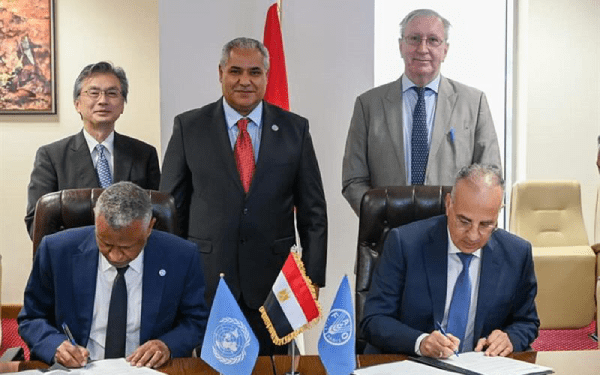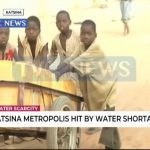Egypt’s Ministry of Irrigation and Water Resources has signed three agreements with the UN Food and Agriculture Organisation (FAO) on water consumption rationalisation projects funded by the Netherlands and Japan, according to a cabinet statement released on Thursday.
The first project uses remote sensing to examine the productivity of water and land resources. It is the second stage of a project created in collaboration with the Dutch government.
The second project aims to increase water productivity for agriculture and is developed in partnership with the Japanese government.
The third project is developed in partnership with the Dutch government to modernize irrigation techniques to improve the quality of life for small farmers in Upper Egypt.
More than 85 percent of Egypt’s river waters flow from the Ethiopian highlands through the Blue Nile — one of the Nile’s two main tributaries along with the White Nile.
According to the National Water Resources Plan 2017-37, the nation, which has a population estimated at over 104 million and is projected to grow by 75 million by the year 2050, overcomes water scarcity by importing 54 percent of its virtual water, which is the embedded water needed to produce commodities, and reusing 42 percent of its renewable water.
Egypt’s Ministry of Irrigation and Water Resources has signed three agreements with the UN Food and Agriculture Organisation (FAO) on water consumption rationalisation projects funded by the Netherlands and Japan, according to a cabinet statement released on Thursday.
The first project uses remote sensing to examine the productivity of water and land resources. It is the second stage of a project created in collaboration with the Dutch government.
The second project aims to increase water productivity for agriculture and is developed in partnership with the Japanese government.
The third project is developed in partnership with the Dutch government to modernize irrigation techniques to improve the quality of life for small farmers in Upper Egypt.
More than 85 percent of Egypt’s river waters flow from the Ethiopian highlands through the Blue Nile — one of the Nile’s two main tributaries along with the White Nile.
According to the National Water Resources Plan 2017-37, the nation, which has a population estimated at over 104 million and is projected to grow by 75 million by the year 2050, overcomes water scarcity by importing 54 percent of its virtual water, which is the embedded water needed to produce commodities, and reusing 42 percent of its renewable water.
Egypt’s Ministry of Irrigation and Water Resources has signed three agreements with the UN Food and Agriculture Organisation (FAO) on water consumption rationalisation projects funded by the Netherlands and Japan, according to a cabinet statement released on Thursday.
The first project uses remote sensing to examine the productivity of water and land resources. It is the second stage of a project created in collaboration with the Dutch government.
The second project aims to increase water productivity for agriculture and is developed in partnership with the Japanese government.
The third project is developed in partnership with the Dutch government to modernize irrigation techniques to improve the quality of life for small farmers in Upper Egypt.
More than 85 percent of Egypt’s river waters flow from the Ethiopian highlands through the Blue Nile — one of the Nile’s two main tributaries along with the White Nile.
According to the National Water Resources Plan 2017-37, the nation, which has a population estimated at over 104 million and is projected to grow by 75 million by the year 2050, overcomes water scarcity by importing 54 percent of its virtual water, which is the embedded water needed to produce commodities, and reusing 42 percent of its renewable water.
Egypt’s Ministry of Irrigation and Water Resources has signed three agreements with the UN Food and Agriculture Organisation (FAO) on water consumption rationalisation projects funded by the Netherlands and Japan, according to a cabinet statement released on Thursday.
The first project uses remote sensing to examine the productivity of water and land resources. It is the second stage of a project created in collaboration with the Dutch government.
The second project aims to increase water productivity for agriculture and is developed in partnership with the Japanese government.
The third project is developed in partnership with the Dutch government to modernize irrigation techniques to improve the quality of life for small farmers in Upper Egypt.
More than 85 percent of Egypt’s river waters flow from the Ethiopian highlands through the Blue Nile — one of the Nile’s two main tributaries along with the White Nile.
According to the National Water Resources Plan 2017-37, the nation, which has a population estimated at over 104 million and is projected to grow by 75 million by the year 2050, overcomes water scarcity by importing 54 percent of its virtual water, which is the embedded water needed to produce commodities, and reusing 42 percent of its renewable water.
Egypt’s Ministry of Irrigation and Water Resources has signed three agreements with the UN Food and Agriculture Organisation (FAO) on water consumption rationalisation projects funded by the Netherlands and Japan, according to a cabinet statement released on Thursday.
The first project uses remote sensing to examine the productivity of water and land resources. It is the second stage of a project created in collaboration with the Dutch government.
The second project aims to increase water productivity for agriculture and is developed in partnership with the Japanese government.
The third project is developed in partnership with the Dutch government to modernize irrigation techniques to improve the quality of life for small farmers in Upper Egypt.
More than 85 percent of Egypt’s river waters flow from the Ethiopian highlands through the Blue Nile — one of the Nile’s two main tributaries along with the White Nile.
According to the National Water Resources Plan 2017-37, the nation, which has a population estimated at over 104 million and is projected to grow by 75 million by the year 2050, overcomes water scarcity by importing 54 percent of its virtual water, which is the embedded water needed to produce commodities, and reusing 42 percent of its renewable water.
Egypt’s Ministry of Irrigation and Water Resources has signed three agreements with the UN Food and Agriculture Organisation (FAO) on water consumption rationalisation projects funded by the Netherlands and Japan, according to a cabinet statement released on Thursday.
The first project uses remote sensing to examine the productivity of water and land resources. It is the second stage of a project created in collaboration with the Dutch government.
The second project aims to increase water productivity for agriculture and is developed in partnership with the Japanese government.
The third project is developed in partnership with the Dutch government to modernize irrigation techniques to improve the quality of life for small farmers in Upper Egypt.
More than 85 percent of Egypt’s river waters flow from the Ethiopian highlands through the Blue Nile — one of the Nile’s two main tributaries along with the White Nile.
According to the National Water Resources Plan 2017-37, the nation, which has a population estimated at over 104 million and is projected to grow by 75 million by the year 2050, overcomes water scarcity by importing 54 percent of its virtual water, which is the embedded water needed to produce commodities, and reusing 42 percent of its renewable water.
Egypt’s Ministry of Irrigation and Water Resources has signed three agreements with the UN Food and Agriculture Organisation (FAO) on water consumption rationalisation projects funded by the Netherlands and Japan, according to a cabinet statement released on Thursday.
The first project uses remote sensing to examine the productivity of water and land resources. It is the second stage of a project created in collaboration with the Dutch government.
The second project aims to increase water productivity for agriculture and is developed in partnership with the Japanese government.
The third project is developed in partnership with the Dutch government to modernize irrigation techniques to improve the quality of life for small farmers in Upper Egypt.
More than 85 percent of Egypt’s river waters flow from the Ethiopian highlands through the Blue Nile — one of the Nile’s two main tributaries along with the White Nile.
According to the National Water Resources Plan 2017-37, the nation, which has a population estimated at over 104 million and is projected to grow by 75 million by the year 2050, overcomes water scarcity by importing 54 percent of its virtual water, which is the embedded water needed to produce commodities, and reusing 42 percent of its renewable water.
Egypt’s Ministry of Irrigation and Water Resources has signed three agreements with the UN Food and Agriculture Organisation (FAO) on water consumption rationalisation projects funded by the Netherlands and Japan, according to a cabinet statement released on Thursday.
The first project uses remote sensing to examine the productivity of water and land resources. It is the second stage of a project created in collaboration with the Dutch government.
The second project aims to increase water productivity for agriculture and is developed in partnership with the Japanese government.
The third project is developed in partnership with the Dutch government to modernize irrigation techniques to improve the quality of life for small farmers in Upper Egypt.
More than 85 percent of Egypt’s river waters flow from the Ethiopian highlands through the Blue Nile — one of the Nile’s two main tributaries along with the White Nile.
According to the National Water Resources Plan 2017-37, the nation, which has a population estimated at over 104 million and is projected to grow by 75 million by the year 2050, overcomes water scarcity by importing 54 percent of its virtual water, which is the embedded water needed to produce commodities, and reusing 42 percent of its renewable water.













